University Accounting Report: ACC204 Corporate Financial Reporting
VerifiedAdded on 2020/05/28
|9
|1505
|61
Report
AI Summary
This report focuses on corporate accounting and financial reporting (ACC204), specifically addressing the reversal of impairment loss for cash-generating units (CGUs). It begins by defining impaired assets according to AASB 136 and explains the process of determining recoverable amounts, including the use of both external and internal sources of information to identify impairment indicators. The report details the calculation of the value in use and fair value less costs of disposal, which are critical for assessing impairment. The guidelines for identifying CGUs, determining their carrying amounts, and recognizing impairment loss are also provided. The report further explains the allocation of impairment loss to goodwill and other assets within a CGU. Part A of the report focuses on the reversal of impairment loss for CGUs and Part B provides the computation of impairment loss and related journal entries. The report emphasizes that the reversal of impairment loss is allocated to assets under the unit without considering the goodwill on a pro-rata basis dependent on the carrying amount of the asset. The increase in carrying amount must be treated as the reversal for the impairment losses for each of the assets and are recognized immediately under the profit and loss account. The report also includes references to relevant academic literature, providing context and supporting evidence for the concepts discussed.
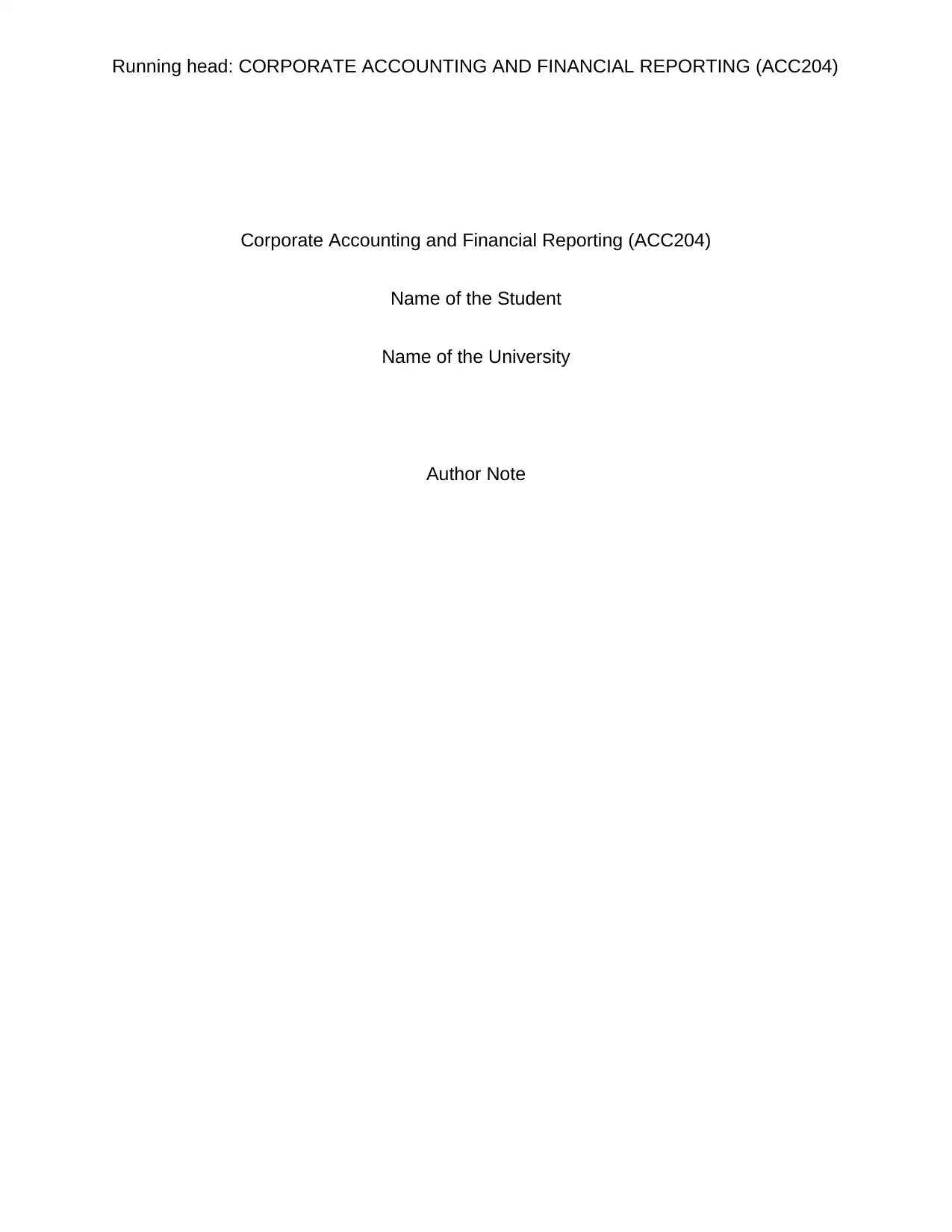
Running head: CORPORATE ACCOUNTING AND FINANCIAL REPORTING (ACC204)
Corporate Accounting and Financial Reporting (ACC204)
Name of the Student
Name of the University
Author Note
Corporate Accounting and Financial Reporting (ACC204)
Name of the Student
Name of the University
Author Note
Paraphrase This Document
Need a fresh take? Get an instant paraphrase of this document with our AI Paraphraser
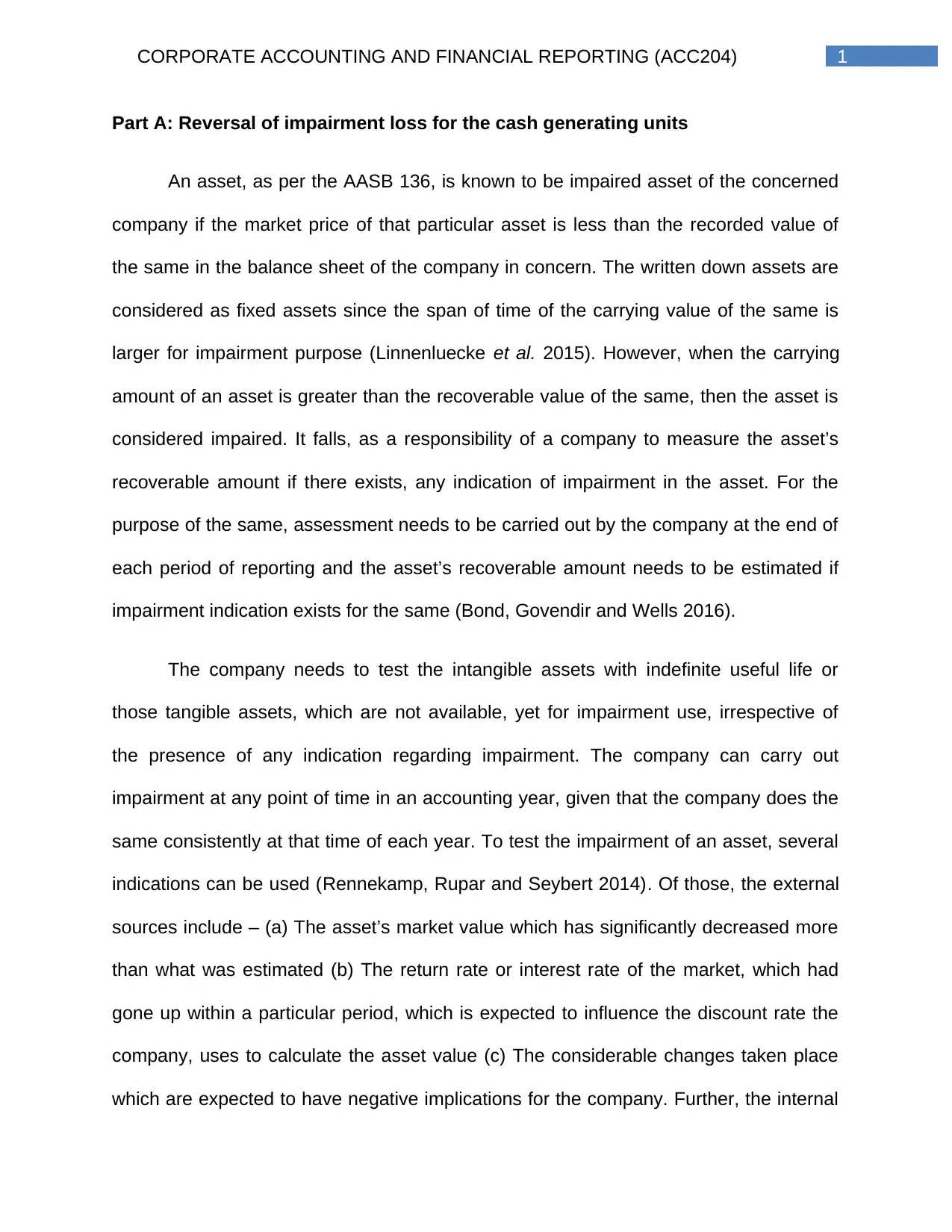
1CORPORATE ACCOUNTING AND FINANCIAL REPORTING (ACC204)
Part A: Reversal of impairment loss for the cash generating units
An asset, as per the AASB 136, is known to be impaired asset of the concerned
company if the market price of that particular asset is less than the recorded value of
the same in the balance sheet of the company in concern. The written down assets are
considered as fixed assets since the span of time of the carrying value of the same is
larger for impairment purpose (Linnenluecke et al. 2015). However, when the carrying
amount of an asset is greater than the recoverable value of the same, then the asset is
considered impaired. It falls, as a responsibility of a company to measure the asset’s
recoverable amount if there exists, any indication of impairment in the asset. For the
purpose of the same, assessment needs to be carried out by the company at the end of
each period of reporting and the asset’s recoverable amount needs to be estimated if
impairment indication exists for the same (Bond, Govendir and Wells 2016).
The company needs to test the intangible assets with indefinite useful life or
those tangible assets, which are not available, yet for impairment use, irrespective of
the presence of any indication regarding impairment. The company can carry out
impairment at any point of time in an accounting year, given that the company does the
same consistently at that time of each year. To test the impairment of an asset, several
indications can be used (Rennekamp, Rupar and Seybert 2014). Of those, the external
sources include – (a) The asset’s market value which has significantly decreased more
than what was estimated (b) The return rate or interest rate of the market, which had
gone up within a particular period, which is expected to influence the discount rate the
company, uses to calculate the asset value (c) The considerable changes taken place
which are expected to have negative implications for the company. Further, the internal
Part A: Reversal of impairment loss for the cash generating units
An asset, as per the AASB 136, is known to be impaired asset of the concerned
company if the market price of that particular asset is less than the recorded value of
the same in the balance sheet of the company in concern. The written down assets are
considered as fixed assets since the span of time of the carrying value of the same is
larger for impairment purpose (Linnenluecke et al. 2015). However, when the carrying
amount of an asset is greater than the recoverable value of the same, then the asset is
considered impaired. It falls, as a responsibility of a company to measure the asset’s
recoverable amount if there exists, any indication of impairment in the asset. For the
purpose of the same, assessment needs to be carried out by the company at the end of
each period of reporting and the asset’s recoverable amount needs to be estimated if
impairment indication exists for the same (Bond, Govendir and Wells 2016).
The company needs to test the intangible assets with indefinite useful life or
those tangible assets, which are not available, yet for impairment use, irrespective of
the presence of any indication regarding impairment. The company can carry out
impairment at any point of time in an accounting year, given that the company does the
same consistently at that time of each year. To test the impairment of an asset, several
indications can be used (Rennekamp, Rupar and Seybert 2014). Of those, the external
sources include – (a) The asset’s market value which has significantly decreased more
than what was estimated (b) The return rate or interest rate of the market, which had
gone up within a particular period, which is expected to influence the discount rate the
company, uses to calculate the asset value (c) The considerable changes taken place
which are expected to have negative implications for the company. Further, the internal
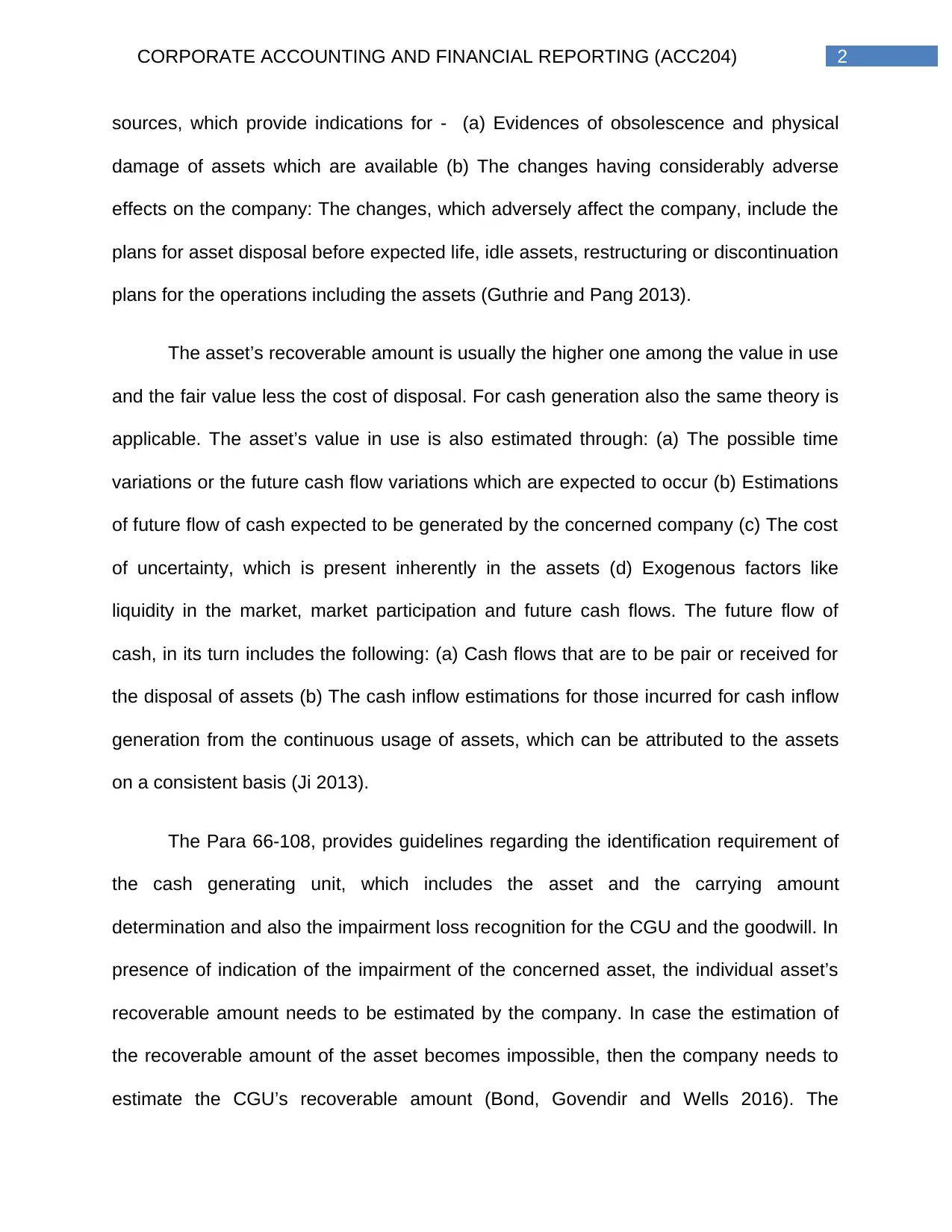
2CORPORATE ACCOUNTING AND FINANCIAL REPORTING (ACC204)
sources, which provide indications for - (a) Evidences of obsolescence and physical
damage of assets which are available (b) The changes having considerably adverse
effects on the company: The changes, which adversely affect the company, include the
plans for asset disposal before expected life, idle assets, restructuring or discontinuation
plans for the operations including the assets (Guthrie and Pang 2013).
The asset’s recoverable amount is usually the higher one among the value in use
and the fair value less the cost of disposal. For cash generation also the same theory is
applicable. The asset’s value in use is also estimated through: (a) The possible time
variations or the future cash flow variations which are expected to occur (b) Estimations
of future flow of cash expected to be generated by the concerned company (c) The cost
of uncertainty, which is present inherently in the assets (d) Exogenous factors like
liquidity in the market, market participation and future cash flows. The future flow of
cash, in its turn includes the following: (a) Cash flows that are to be pair or received for
the disposal of assets (b) The cash inflow estimations for those incurred for cash inflow
generation from the continuous usage of assets, which can be attributed to the assets
on a consistent basis (Ji 2013).
The Para 66-108, provides guidelines regarding the identification requirement of
the cash generating unit, which includes the asset and the carrying amount
determination and also the impairment loss recognition for the CGU and the goodwill. In
presence of indication of the impairment of the concerned asset, the individual asset’s
recoverable amount needs to be estimated by the company. In case the estimation of
the recoverable amount of the asset becomes impossible, then the company needs to
estimate the CGU’s recoverable amount (Bond, Govendir and Wells 2016). The
sources, which provide indications for - (a) Evidences of obsolescence and physical
damage of assets which are available (b) The changes having considerably adverse
effects on the company: The changes, which adversely affect the company, include the
plans for asset disposal before expected life, idle assets, restructuring or discontinuation
plans for the operations including the assets (Guthrie and Pang 2013).
The asset’s recoverable amount is usually the higher one among the value in use
and the fair value less the cost of disposal. For cash generation also the same theory is
applicable. The asset’s value in use is also estimated through: (a) The possible time
variations or the future cash flow variations which are expected to occur (b) Estimations
of future flow of cash expected to be generated by the concerned company (c) The cost
of uncertainty, which is present inherently in the assets (d) Exogenous factors like
liquidity in the market, market participation and future cash flows. The future flow of
cash, in its turn includes the following: (a) Cash flows that are to be pair or received for
the disposal of assets (b) The cash inflow estimations for those incurred for cash inflow
generation from the continuous usage of assets, which can be attributed to the assets
on a consistent basis (Ji 2013).
The Para 66-108, provides guidelines regarding the identification requirement of
the cash generating unit, which includes the asset and the carrying amount
determination and also the impairment loss recognition for the CGU and the goodwill. In
presence of indication of the impairment of the concerned asset, the individual asset’s
recoverable amount needs to be estimated by the company. In case the estimation of
the recoverable amount of the asset becomes impossible, then the company needs to
estimate the CGU’s recoverable amount (Bond, Govendir and Wells 2016). The
⊘ This is a preview!⊘
Do you want full access?
Subscribe today to unlock all pages.

Trusted by 1+ million students worldwide
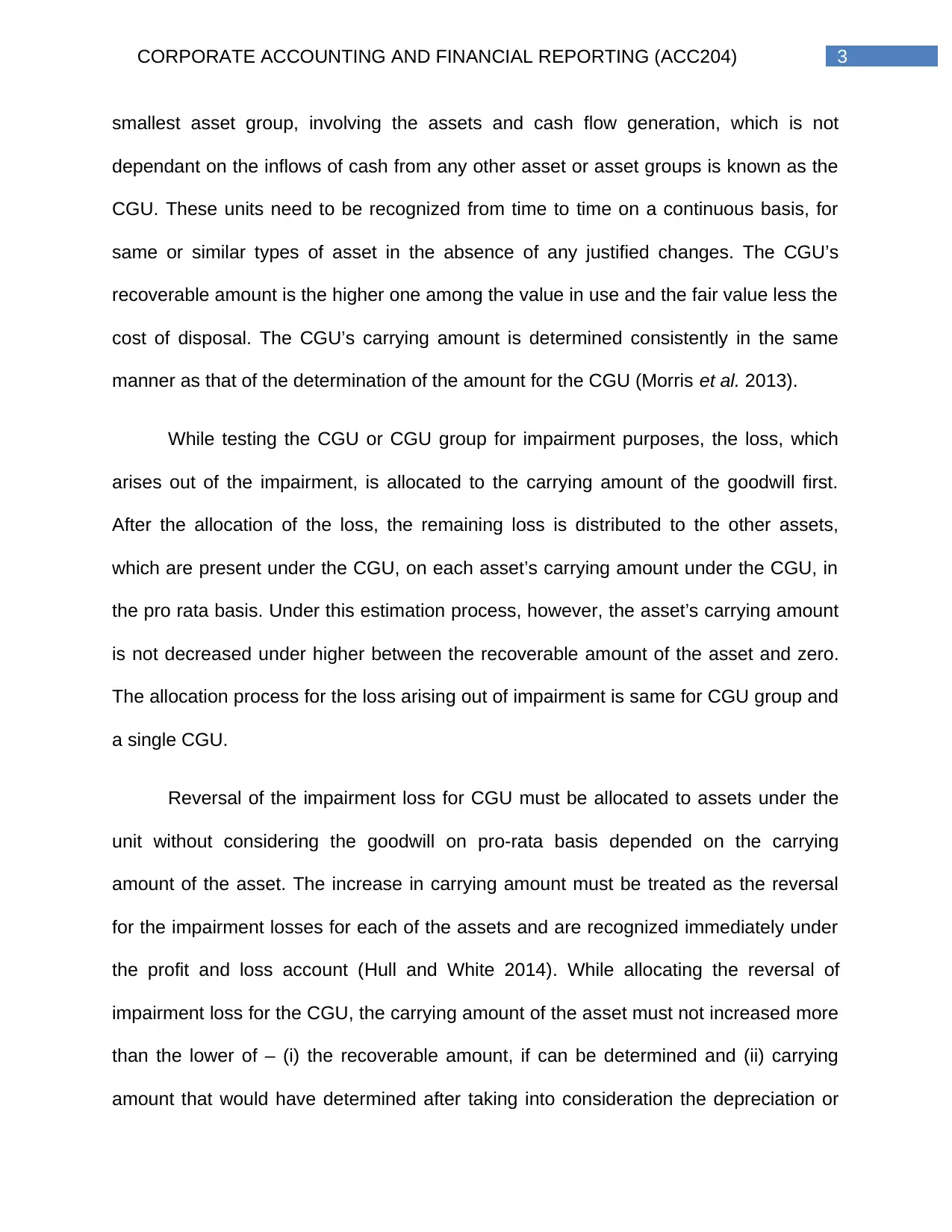
3CORPORATE ACCOUNTING AND FINANCIAL REPORTING (ACC204)
smallest asset group, involving the assets and cash flow generation, which is not
dependant on the inflows of cash from any other asset or asset groups is known as the
CGU. These units need to be recognized from time to time on a continuous basis, for
same or similar types of asset in the absence of any justified changes. The CGU’s
recoverable amount is the higher one among the value in use and the fair value less the
cost of disposal. The CGU’s carrying amount is determined consistently in the same
manner as that of the determination of the amount for the CGU (Morris et al. 2013).
While testing the CGU or CGU group for impairment purposes, the loss, which
arises out of the impairment, is allocated to the carrying amount of the goodwill first.
After the allocation of the loss, the remaining loss is distributed to the other assets,
which are present under the CGU, on each asset’s carrying amount under the CGU, in
the pro rata basis. Under this estimation process, however, the asset’s carrying amount
is not decreased under higher between the recoverable amount of the asset and zero.
The allocation process for the loss arising out of impairment is same for CGU group and
a single CGU.
Reversal of the impairment loss for CGU must be allocated to assets under the
unit without considering the goodwill on pro-rata basis depended on the carrying
amount of the asset. The increase in carrying amount must be treated as the reversal
for the impairment losses for each of the assets and are recognized immediately under
the profit and loss account (Hull and White 2014). While allocating the reversal of
impairment loss for the CGU, the carrying amount of the asset must not increased more
than the lower of – (i) the recoverable amount, if can be determined and (ii) carrying
amount that would have determined after taking into consideration the depreciation or
smallest asset group, involving the assets and cash flow generation, which is not
dependant on the inflows of cash from any other asset or asset groups is known as the
CGU. These units need to be recognized from time to time on a continuous basis, for
same or similar types of asset in the absence of any justified changes. The CGU’s
recoverable amount is the higher one among the value in use and the fair value less the
cost of disposal. The CGU’s carrying amount is determined consistently in the same
manner as that of the determination of the amount for the CGU (Morris et al. 2013).
While testing the CGU or CGU group for impairment purposes, the loss, which
arises out of the impairment, is allocated to the carrying amount of the goodwill first.
After the allocation of the loss, the remaining loss is distributed to the other assets,
which are present under the CGU, on each asset’s carrying amount under the CGU, in
the pro rata basis. Under this estimation process, however, the asset’s carrying amount
is not decreased under higher between the recoverable amount of the asset and zero.
The allocation process for the loss arising out of impairment is same for CGU group and
a single CGU.
Reversal of the impairment loss for CGU must be allocated to assets under the
unit without considering the goodwill on pro-rata basis depended on the carrying
amount of the asset. The increase in carrying amount must be treated as the reversal
for the impairment losses for each of the assets and are recognized immediately under
the profit and loss account (Hull and White 2014). While allocating the reversal of
impairment loss for the CGU, the carrying amount of the asset must not increased more
than the lower of – (i) the recoverable amount, if can be determined and (ii) carrying
amount that would have determined after taking into consideration the depreciation or
Paraphrase This Document
Need a fresh take? Get an instant paraphrase of this document with our AI Paraphraser
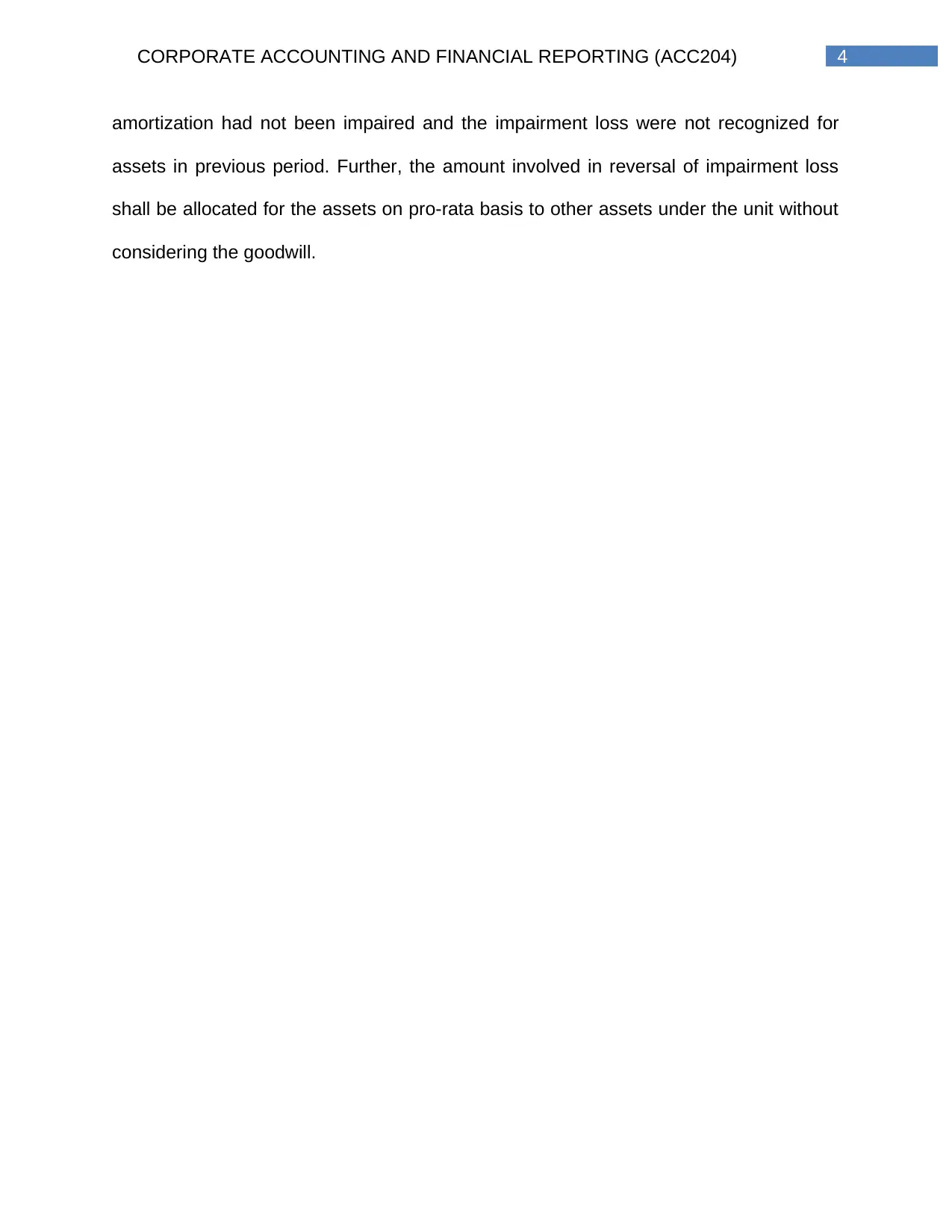
4CORPORATE ACCOUNTING AND FINANCIAL REPORTING (ACC204)
amortization had not been impaired and the impairment loss were not recognized for
assets in previous period. Further, the amount involved in reversal of impairment loss
shall be allocated for the assets on pro-rata basis to other assets under the unit without
considering the goodwill.
amortization had not been impaired and the impairment loss were not recognized for
assets in previous period. Further, the amount involved in reversal of impairment loss
shall be allocated for the assets on pro-rata basis to other assets under the unit without
considering the goodwill.
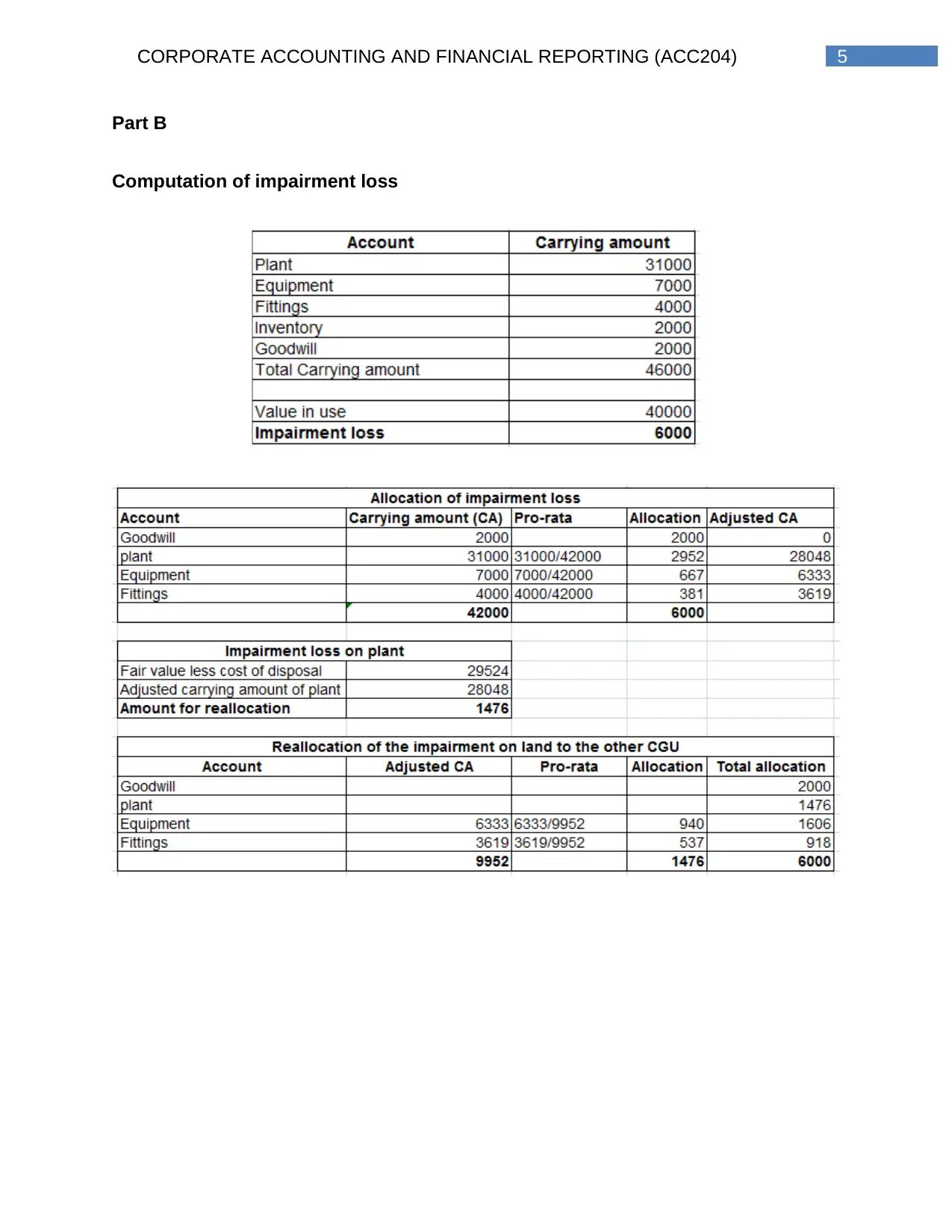
5CORPORATE ACCOUNTING AND FINANCIAL REPORTING (ACC204)
Part B
Computation of impairment loss
Part B
Computation of impairment loss
⊘ This is a preview!⊘
Do you want full access?
Subscribe today to unlock all pages.

Trusted by 1+ million students worldwide
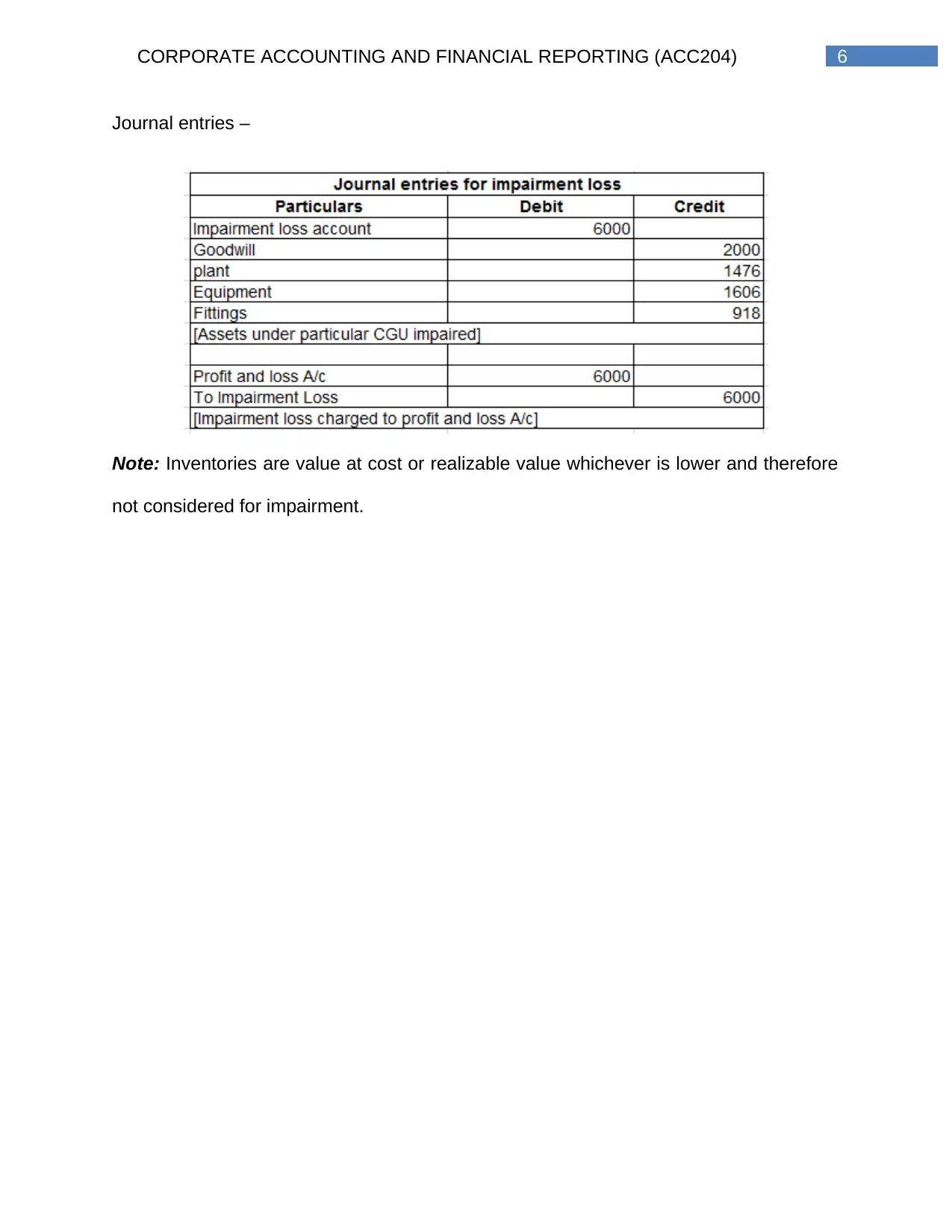
6CORPORATE ACCOUNTING AND FINANCIAL REPORTING (ACC204)
Journal entries –
Note: Inventories are value at cost or realizable value whichever is lower and therefore
not considered for impairment.
Journal entries –
Note: Inventories are value at cost or realizable value whichever is lower and therefore
not considered for impairment.
Paraphrase This Document
Need a fresh take? Get an instant paraphrase of this document with our AI Paraphraser
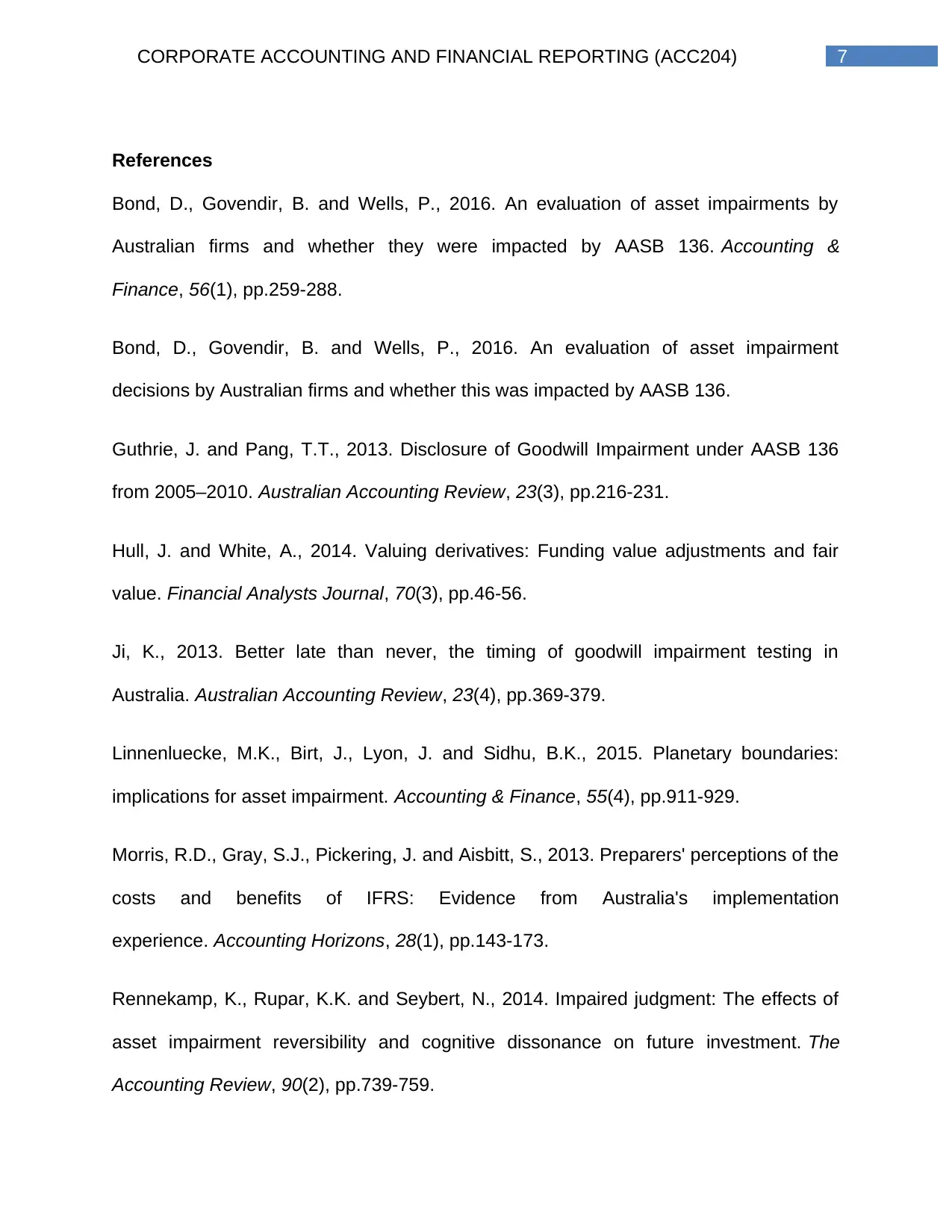
7CORPORATE ACCOUNTING AND FINANCIAL REPORTING (ACC204)
References
Bond, D., Govendir, B. and Wells, P., 2016. An evaluation of asset impairments by
Australian firms and whether they were impacted by AASB 136. Accounting &
Finance, 56(1), pp.259-288.
Bond, D., Govendir, B. and Wells, P., 2016. An evaluation of asset impairment
decisions by Australian firms and whether this was impacted by AASB 136.
Guthrie, J. and Pang, T.T., 2013. Disclosure of Goodwill Impairment under AASB 136
from 2005–2010. Australian Accounting Review, 23(3), pp.216-231.
Hull, J. and White, A., 2014. Valuing derivatives: Funding value adjustments and fair
value. Financial Analysts Journal, 70(3), pp.46-56.
Ji, K., 2013. Better late than never, the timing of goodwill impairment testing in
Australia. Australian Accounting Review, 23(4), pp.369-379.
Linnenluecke, M.K., Birt, J., Lyon, J. and Sidhu, B.K., 2015. Planetary boundaries:
implications for asset impairment. Accounting & Finance, 55(4), pp.911-929.
Morris, R.D., Gray, S.J., Pickering, J. and Aisbitt, S., 2013. Preparers' perceptions of the
costs and benefits of IFRS: Evidence from Australia's implementation
experience. Accounting Horizons, 28(1), pp.143-173.
Rennekamp, K., Rupar, K.K. and Seybert, N., 2014. Impaired judgment: The effects of
asset impairment reversibility and cognitive dissonance on future investment. The
Accounting Review, 90(2), pp.739-759.
References
Bond, D., Govendir, B. and Wells, P., 2016. An evaluation of asset impairments by
Australian firms and whether they were impacted by AASB 136. Accounting &
Finance, 56(1), pp.259-288.
Bond, D., Govendir, B. and Wells, P., 2016. An evaluation of asset impairment
decisions by Australian firms and whether this was impacted by AASB 136.
Guthrie, J. and Pang, T.T., 2013. Disclosure of Goodwill Impairment under AASB 136
from 2005–2010. Australian Accounting Review, 23(3), pp.216-231.
Hull, J. and White, A., 2014. Valuing derivatives: Funding value adjustments and fair
value. Financial Analysts Journal, 70(3), pp.46-56.
Ji, K., 2013. Better late than never, the timing of goodwill impairment testing in
Australia. Australian Accounting Review, 23(4), pp.369-379.
Linnenluecke, M.K., Birt, J., Lyon, J. and Sidhu, B.K., 2015. Planetary boundaries:
implications for asset impairment. Accounting & Finance, 55(4), pp.911-929.
Morris, R.D., Gray, S.J., Pickering, J. and Aisbitt, S., 2013. Preparers' perceptions of the
costs and benefits of IFRS: Evidence from Australia's implementation
experience. Accounting Horizons, 28(1), pp.143-173.
Rennekamp, K., Rupar, K.K. and Seybert, N., 2014. Impaired judgment: The effects of
asset impairment reversibility and cognitive dissonance on future investment. The
Accounting Review, 90(2), pp.739-759.

8CORPORATE ACCOUNTING AND FINANCIAL REPORTING (ACC204)
⊘ This is a preview!⊘
Do you want full access?
Subscribe today to unlock all pages.

Trusted by 1+ million students worldwide
1 out of 9
Related Documents
Your All-in-One AI-Powered Toolkit for Academic Success.
+13062052269
info@desklib.com
Available 24*7 on WhatsApp / Email
![[object Object]](/_next/static/media/star-bottom.7253800d.svg)
Unlock your academic potential
Copyright © 2020–2025 A2Z Services. All Rights Reserved. Developed and managed by ZUCOL.




